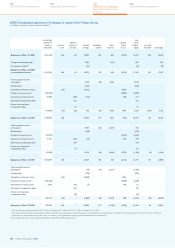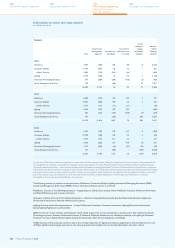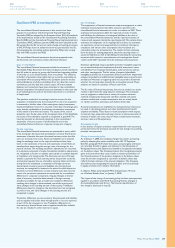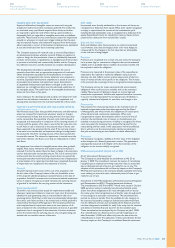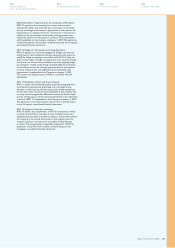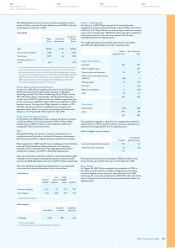Philips 2008 Annual Report Download - page 211
Download and view the complete annual report
Please find page 211 of the 2008 Philips annual report below. You can navigate through the pages in the report by either clicking on the pages listed below, or by using the keyword search tool below to find specific information within the annual report.
Actuarial gains and losses arise mainly from changes in actuarial
assumptions and differences between actuarial assumptions and what
has actually occurred. The Company recognizes all actuarial gains and
losses directly in equity through the statement of recognized income
and expense.
To the extent that postemployment benefits vest immediately following
the introduction of a change to a defined-benefit plan, the resulting
past service costs are recognized immediately.
Obligations for contributions to defined-contribution pension plans
are recognized as an expense in the income statement as incurred.
In certain countries, the Company also provides postretirement
benefits other than pensions. The costs relating to such plans consist
primarily of the present value of the benefits attributed on an equal
basis to each year of service, interest cost on the accumulated
postretirement benefit obligation, which is a discounted amount,
and amortization of the unrecognized transition obligation.
Share-based payment
The Company recognizes the estimated fair value, measured as of grant
date of equity instruments granted to employees as compensation
expense over the vesting period on a straight-line basis, taking into
account expected forfeitures. The Company uses the Black-Scholes
option-pricing model to determine the fair value of the equity
instruments.
The fair value of the amount payable to employees in respect of share
appreciation rights, which are settled in cash, is recognized as an
expense, with a corresponding increase in liabilities, over the vesting
period. The liability is remeasured at each reporting date and at
settlement date. Any changes in fair value of the liability are recognized
as personnel expense in the statement of income.
Income tax
Income tax comprises current and deferred tax. Income tax is
recognized in the statement of income except to the extent that it
relates to an item recognized directly within equity, in which case the
tax effect is recognized in equity as well. Current tax is the expected
tax payable on the taxable income for the year, using tax rates enacted
or substantially enacted at the balance sheet date, and any adjustment
to tax payable in respect of previous years. Deferred tax assets and
liabilities are recognized, using the balance sheet method, for the
expected tax consequences of temporary differences between the tax
base of assets and liabilities and their carrying amounts for financial
reporting purposes. Deferred tax is not recognized for the following
temporary differences: the initial recognition of goodwill, the initial
recognition of assets and liabilities in a transaction that is not a
business combination and that affects neither accounting nor taxable
profit, and differences relating to investments in subsidiaries to the
extent that they probably will not reverse in the foreseeable future.
Measurement of deferred tax assets and liabilities is based upon the
enacted or substantially enacted tax rates expected to apply to taxable
income in the years in which those temporary differences are expected
to be recovered or settled. Deferred tax assets, including assets arising
from loss carry-forwards, are recognized if it is probable that the asset
will be realized. Deferred tax assets are reviewed each reporting date
and reduced to the extent that it is no longer probable that sufficient
taxable income will be available to allow all or part of the asset to be
recovered. Deferred tax assets and liabilities are not discounted.
Deferred tax liabilities for withholding taxes are recognized for
subsidiaries in situations where the income is to be paid out as
dividend in the foreseeable future, and for undistributed earnings of
unconsolidated companies to the extent that these withholding taxes
are not expected to be refundable and deductible. Changes in tax
rates are reflected in the period when the change has been enacted
or substantively enacted by the balance sheet date.
Leases
Leases in which a significant portion of the risks and rewards of
ownership are retained by the lessor are classified as operating leases.
Payments made under operating leases are recognized in the statement
of income on a straight-line basis over the term of the lease. Leases
in which the Company has substantially all the risks and rewards of
ownership are classified as finance leases. Finance leases are capitalized
at the lease’s commencement at the lower of the fair value of the
leased property and the present value of the minimum lease payments.
Each lease payment is allocated between the liability and finance
charges so as to achieve a constant rate of interest on the finance
balance outstanding. The corresponding rental obligations, net
of finance charges, are included in other short-term and other
non-current liabilities. The property, plant and equipment acquired
under finance leases is depreciated over the shorter of the useful life
of the assets and the lease term.
Derivative financial instruments
The Company uses derivative financial instruments principally to manage
its foreign currency risks and, to a more limited extent, for managing
interest rate and commodity price risks. All derivative financial
instruments are classified as current assets or liabilities based on
their maturity dates and are accounted for at trade date. Embedded
derivatives are separated from the host contract and accounted for
separately if required by IAS 39 Financial Instruments: Recognition
and Measurement. The Company measures all derivative financial
instruments based on fair values derived from market prices of the
instruments or from option pricing models, as appropriate. Gains or
losses arising from changes in fair value of derivatives are recognized
in the statement of income, except for derivatives that are highly
effective and qualify for cash flow or net investment hedge accounting.
Changes in the fair value of a derivative that is highly effective and
that is designated and qualifies as a fair value hedge, along with the
loss or gain on the hedged asset, or liability or unrecognized firm
commitment of the hedged item that is attributable to the hedged
risk, are recorded in the statement of income.
Changes in the fair value of a derivative that is highly effective and
that is designated and qualifies as a cash flow hedge, are recorded in
equity, until statement of income is affected by the variability in cash
flows of the designated hedged item. To the extent that the hedge is
ineffective, changes in the fair value are recognized in the statement
of income.
The Company formally assesses, both at the hedge’s inception and
on an ongoing basis, whether the derivatives that are used in hedging
transactions are highly effective in offsetting changes in fair values or
cash flows of hedged items. When it is established that a derivative
is not highly effective as a hedge or that it has ceased to be a highly
effective hedge, the Company discontinues hedge accounting
prospectively. When hedge accounting is discontinued because it has
been established that the derivative no longer qualifies as an effective
fair value hedge, the Company continues to carry the derivative on
the balance sheet at its fair value, and no longer adjusts the hedged
asset or liability for changes in fair value.
When hedge accounting is discontinued because it is expected that
a forecasted transaction will not occur, the Company continues to
carry the derivative on the balance sheet at its fair value, and gains
and losses that were accumulated in equity are recognized
immediately in the income statement. If there is a delay and it is
expected that the transaction will still occur, the amount in equity
remains there until the forecasted transaction affects income. In all
other situations in which hedge accounting is discontinued, the
Company continues to carry the derivative at its fair value on the
balance sheet, and recognizes any changes in its fair value in the
statement of income. For interest rate swaps designated as a fair value
hedge of an interest bearing asset or liability that are unwound, the
amount of the fair value adjustment to the asset or liability for the
risk being hedged is released to the income statement over the
remaining life of the asset or liability based on the recalculated
effective yield.
Foreign currency differences arising on the retranslation of a financial
liability designated as a hedge of a net investment in a foreign operation
are recognized directly as a separate component of equity, to the
extent that the hedge is effective. To the extent that the hedge is
ineffective, such differences are recognized in the statement of income.
Non-derivative financial instruments
Non-derivative financial instruments are recognized initially at fair
value when the Company becomes a party to the contractual
provisions of the instrument. They are derecognized if the Company’s
contractual rights to the cash flows from the financial instruments
expire or if the Company transfers the financial instruments to another
party without retaining control or substantially all risks and rewards
of the instruments. Regular way purchases and sales of financial
instruments are accounted for at trade date. Dividend and interest
income are recognized when earned. Gains or losses, if any, are
recorded in financial income and expenses.
Cash and cash equivalents
Cash and cash equivalents include all cash balances and short-term
highly liquid investments with an original maturity of three months
or less that are readily convertible into known amounts of cash.
They are stated at face value which approximates fair value.
Receivables
Trade accounts receivable are carried at the lower of amortized cost
or the present value of estimated future cash flows, taking into account
Philips Annual Report 2008 211
254
Corporate governance
250
Reconciliation of
non-US GAAP information
262
Ten-year overview
266
Investor information





